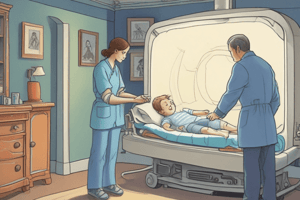Podcast
Questions and Answers
What is the primary function of an X-ray detector in radiology?
What is the primary function of an X-ray detector in radiology?
- To convert X-ray energy into a visible image (correct)
- To amplify the X-ray signal to improve image quality
- To produce X-rays through high-voltage electrical discharge
- To evaluate injuries and diseases
What is the main principle behind X-ray imaging in radiology?
What is the main principle behind X-ray imaging in radiology?
- X-rays interact with tissue and bones, producing scattering
- X-rays interact with tissue and bones, producing fluorescence
- X-rays interact with tissue and bones, producing electromagnetic radiation
- X-rays interact with tissue and bones, producing attenuation (correct)
What is the purpose of the ALARA principle in radiology?
What is the purpose of the ALARA principle in radiology?
- To reduce the cost of radiology equipment
- To minimize radiation exposure to patients and staff (correct)
- To maximize radiation exposure to patients and staff
- To optimize image quality in radiology
What is the primary application of X-ray imaging in radiology?
What is the primary application of X-ray imaging in radiology?
What is the main difference between conventional radiography and digital radiography?
What is the main difference between conventional radiography and digital radiography?
Who discovered X-rays?
Who discovered X-rays?
What is the purpose of fluoroscopy in radiology?
What is the purpose of fluoroscopy in radiology?
What is the primary safety concern in radiology?
What is the primary safety concern in radiology?
Flashcards are hidden until you start studying
Study Notes
X-ray in Radiology
Introduction to X-rays
- X-rays are a type of electromagnetic radiation with high energy and frequency
- Discovered by Wilhelm Conrad Röntgen in 1895
- Used in medical imaging to produce diagnostic images of internal structures
Principles of X-ray Imaging
- X-rays interact with tissue and bones, producing attenuation (absorption or scattering)
- Dense materials like bone absorb more X-rays, while soft tissues absorb less
- The resulting attenuation pattern is detected by an X-ray detector, creating an image
X-ray Equipment
- X-ray tube: produces X-rays through high-voltage electrical discharge
- X-ray detector: converts X-ray energy into a visible image
- Image intensifier: amplifies the X-ray signal to improve image quality
- Digital radiography systems: use digital sensors and computers to produce digital images
X-ray Imaging Techniques
- Conventional radiography: uses X-ray film or digital detectors to produce 2D images
- Computed radiography (CR): uses digital detectors and computers to produce digital images
- Digital radiography (DR): uses digital sensors and computers to produce digital images
- Fluoroscopy: uses continuous X-ray exposure to guide interventional procedures
X-ray Applications in Radiology
- Diagnostic imaging: evaluates injuries, diseases, and conditions (e.g., bone fractures, lung diseases)
- Interventional procedures: guides procedures like biopsies,angiograms, and orthopedic surgeries
- Therapy: used in radiation therapy to treat cancer and other conditions
Safety Considerations
- Radiation exposure: X-rays can cause DNA damage and increase cancer risk
- Radiation protection: uses shielding, distance, and time limits to minimize exposure
- ALARA (As Low As Reasonably Achievable) principle: minimizes radiation exposure to patients and staff
X-ray in Radiology
Introduction to X-rays
- X-rays are a high-energy, high-frequency type of electromagnetic radiation
- Discovered by Wilhelm Conrad Röntgen in 1895
- Used in medical imaging to produce diagnostic images of internal structures
Principles of X-ray Imaging
- X-rays interact with tissue and bones, producing attenuation (absorption or scattering) due to differences in density
- Bone absorbs more X-rays, while soft tissues absorb less
- Attenuation pattern is detected by an X-ray detector, creating an image
X-ray Equipment
- X-ray tube produces X-rays through high-voltage electrical discharge
- X-ray detector converts X-ray energy into a visible image
- Image intensifier amplifies the X-ray signal to improve image quality
- Digital radiography systems use digital sensors and computers to produce digital images
X-ray Imaging Techniques
- Conventional radiography produces 2D images using X-ray film or digital detectors
- Computed radiography (CR) uses digital detectors and computers to produce digital images
- Digital radiography (DR) uses digital sensors and computers to produce digital images
- Fluoroscopy uses continuous X-ray exposure to guide interventional procedures
X-ray Applications in Radiology
- Diagnostic imaging evaluates injuries, diseases, and conditions (e.g., bone fractures, lung diseases)
- Interventional procedures guide procedures like biopsies, angiograms, and orthopedic surgeries
- Therapy uses X-rays in radiation therapy to treat cancer and other conditions
Safety Considerations
- Radiation exposure from X-rays can cause DNA damage and increase cancer risk
- Radiation protection uses shielding, distance, and time limits to minimize exposure
- ALARA principle minimizes radiation exposure to patients and staff
Studying That Suits You
Use AI to generate personalized quizzes and flashcards to suit your learning preferences.




